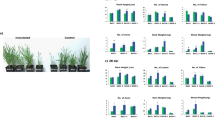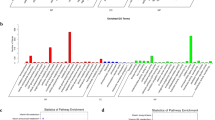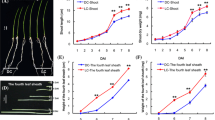Abstract
Inoculation of mango trees with Burkholderia caribensis XV and Rhizobium sp. XXV led to mango growth promotion (dry biomass increased in root 89 %, stem 34 %, leaves 51 %, and foliar area 53 %), floral fate (floral buds 100 %), and increased number of flowers (100 %). Nitrogen content in leaves was similar in inoculated and noninoculated trees, around 1.4 % (optimal condition for floral induction). The total foliar nitrogen content increased significantly (56 %) when the microbial inoculation treatment was applied. In addition, the initial content of sucrose, glucose, and fructose in leaves was higher in the microbial inoculation treatment trees but decreased during the evaluated period. The sucrose content in the noninoculated trees presented similar dynamics compared to the microbial inoculation treatment trees, but glucose and fructose showed increased values compared to those of the microbial inoculation treatment. FLOWERING LOCUS T (FT) expression profiles normalized to ACTIN showed similar dynamics but different expression levels: RQ values of 0.03 and 0.05 for noninoculated and microbial inoculation treatments, respectively. In addition, FT expression profiles in microbial inoculation, normalized to the noninoculated treatment, showed an increased FT expression dynamic over time (up to RQ = 2.2), although a drastic decrease in the last sampling date, when all trees presented developed panicles and flowers, was observed. This FT upregulation was in accordance with the flowering induction in that treatment. Temperature had an important influence on mango flowering induction, which was observed for a 1-month period (~10 °C at night and 20 °C during the day). Bud growth that occurred during that period generated mixed and floral buds depending on the exposure time to these inductive temperatures, less than 2 weeks and more than 3 weeks, respectively. Data indicate that inoculation of mango trees with plant growth-promoting rhizobacteria (associated with this crop) is a potential alternative way to promote growth and induce flowering in mango, greatly reducing the high economical costs and environmental contamination associated with traditional agricultural practices.




Similar content being viewed by others
References
Ahemad M, Saghir MK (2011) Functional aspects of plant growth promoting rhizobacteria: recent advancements. Insight Microbiol 1:39–54
Alikhani HA, Yakhchali B (2009) Potential use of Iranian rhizobial strains as plant growth promoting rhizobacteria (PGPR) and effects of selected strains on growth characteristics of wheat, corn and alfalfa. Desert 14:27–35
Anandham R, Gandhi PI, Madhaiyan M, Sa T (2008) Potential plant growth promoting traits and bioacidulation of rock phosphate by thiosulfate oxidizing bacteria isolated from crop plants. J Basic Microbiol 48:439–447
Aslantas R, Cakmakci R, Sahin F (2007) Effect of plant growth promoting rhizobacteria on young apples trees growth and fruit yield under orchard conditions. Sci Hortic (Amsterdam) 111:371–377
Avilán RL (2008) Nutrición y fertilización del mango. International Plant Nutrition Institute, Norcross
Axmann H, Sebastianelli A, Arrillaga LJ (1990) Sample preparation techniques of biological material for isotope analysis. In: Hardarson G (ed) Use of nuclear techniques in studies of soil-plant relationship. International Atomic Energy Agency, Vienna, p 146
Blaikie SJ, Leonardi J, Chacko EK, Muller WJ, Scott NS (1999) Effect of cincturing and chemical treatments on growth, flowering and yield of mango. Aust J Exp Agric 39:761–770
Bradford M (1976) A rapid and sensitive method for the quantitation of microgram quantities of protein utilizing the principle of protein-dye binding. Anal Biochem 72:248–254
Brito JMC, Ferreira D, Guerrero CAC, Machado AV, Beltrão J (1999) Soil pollution by nitrates using sewage sludge and mineral fertilizers. Dev Plant Soil Sci 86:223–227
Castro Marín I, Loef I, Bartetzko L, Searle I, Coupland G, Stitt M, Osuna D (2011) Nitrate regulates floral induction in Arabidopsis, acting independently of light, gibberellin and autonomous pathways. Planta 233:539–552
Cavalcante VA, Dobereiner J (1988) A new acid-tolerant nitrogen-fixing bacterium associated with sugarcane. Plant Soil 108:23–31
Chacko EK (1991) Mango flowering—still an enigma. Acta Hort 291:12–21
Compant S, Reiter B, Sessitch A, Nowak J, Clément C, Ait Barka E (2005) Endophytic colonization of Vitis vinifera L. by plant growth-promoting bacterium Burkholderia sp. strain PsJN. Appl Environ Microbiol 71:1685–1693
Cull BW (1987) A whole plant approach to productivity research for mango. In: Prenseley RT, Tucker G (eds) Mangoes—a review. Commonwealth Science Council, London, pp 19–28
Davenport TL (2003) Management of flowering in three tropical and subtropical fruit tree species. HortScience 38:1331–1335
Davenport TL (2007) Reproductive physiology of mango. Braz J Plant Physiol 19:363–376
Davenport TL (2009) Reproductive physiology. In: Litz RE (ed) The mango: botany production and uses, 2nd edn. CAB International, Wallingford, pp 97–169
Davenport TL, Zhang T, Ying Z (2006a) Isolation of potentially regulating mango flowering. Proceedings of the 33rd annual meeting of the Plant Growth Regulation Society of America, Quebec City, Canada, July 9–13, 2006. Plant Growth Regulation Society of America, Alexandria, pp 109–110
Davenport TL, Ying Z, Kulkarni V, White TL (2006b) Evidence for a translocatable florigenic promoter in mango. Sci Hortic (Amsterdam) 110:150–159
Davies PJ (2004) The plant hormones: their nature, occurrence and function. In: Davies PJ (ed) Plant hormones: biosynthesis, signal transduction, action!, 3rd edn. Kluwer Academic Publisher, Amsterdam, pp 1–15
de los Santos-Villalobos S, de-Folter S, Délano-Frier JP, Gómez-Lim MA, Guzmán-Ortiz DA, Sánchez-García P, Peña-Cabriales JJ (2011) Puntos críticos en el manejo integral de mango: floración, antracnosis y residuos industriales. Rev Mex Cienc Agríc 2:221–234
de los Santos-Villalobos S, Barrera-Galicia GC, Miranda-Salcedo MA, Peña-Cabriales JJ (2012a) Burkholderia cepacia XXVI siderophore with biocontrol capacity against Colletotrichum gloeosporioides. World J Microbiol Biotechnol 28:2615–2623
de los Santos-Villalobos S, Parra-Cota FI, de-Folter S, Peña-Cabriales JJ (2012b) Primers to amplify flowering locus T (FT) transcript in mango (Mangifera indica) and their potential use in other angiosperms. Plant OMICS 5:453–457
de los Santos-Villalobos S, Guzmán-Ortiz DA, Gómez-Lim MA, Délano-Frier JP, de-Folter S, Sánchez-García P, Peña-Cabriales JJ (2013) Potential use of Trichoderma asperellum (Samuels, Liechfeldt et Nirenberg) T8a as a biological control agent against anthracnose in mango (Mangifera indica L.). Biol Control 64:37–44
Ercisli S, Esitken A, Cangi R, Sahin F (2003) Adventitious root formation of kiwifruit in relation to sampling date, IBA and Agrobacterium rubi inoculation. Plant Growth Regul 41:133–137
FAO (Food and Agriculture Organization of the United Nations) (2009) FAOSTAT. http://faostat.fao.org/. Accessed 18 April 2012
Glick BR, Penrose DM, Li J (1998) A model for the lowering of plant ethylene concentrations by plant growth promoting bacteria. J Theor Biol 190:63–68
Glickmann E, Dessaux Y (1995) A critical examination of the specificity of the Salkowski reagent for indolic compounds produced by phytopathogenic bacteria. Appl Environ Microbiol 61:793–796
Gou J, Strauss SH, Tsai CJ, Fang K, Chen Y, Jiang X, Busov VB (2010) Gibberellins regulate lateral root formation in Populus through interactions with auxin and other hormones. Plant Cell 22:623–639
Hegele M, Bangerth F, Naphrom D, Sruamsiri P, Manochai P (2006) Control of flower induction in tropical/subtropical fruit trees by phytohormones using the example of longan and mango. Acta Hortic 727:217–276
Karadeniz A, Topcuoglu SF, Inan S (2006) Auxin, gibberellin, cytokinin and abscisic acid production in some bacteria. World J Microbiol Biotechnol 22:1061–1064
Katiyar V, Goel R (2004) Siderophore mediated plant growth promotion at low temperature by mutant of fluorescent pseudomonad. Plant Growth Regul 42:239–244
Kenworthy A (1964) Fruit nut and plantation crops. Desidues and everygreen (a guide collecting foliar sample for nutrient analysis). Horticultural Department. Michigan State University, East Lansing, p 30
Kulkarni VJ, Rameshwar A (1989) Effect of deblossoming and defruiting on offseason flowering and fruiting in mango (Mangifera indica L.). Sci Hortic (Amsterdam) 39:143–148
Liu X, Grieve C (2009) Accumulation of chiro-inositol and other non-structural carbohydrates in Limonium species in response to saline irrigation waters. J Am Soc Hortic Sci 34:329–336
Liu C, Thong Z, Yu H (2009) Coming into bloom: the specification of floral meristems. Development 136:3379–3391
Livak KJ, Schmittgen TD (2001) Analysis of relative gene expression data using Real-Time quantitative PCR and the 2-ΔΔCT method. Methods 25:402–408
Maganhotto S, Silva CM, Faria Vieira R, Nicolella G (2003) Paclobutrazol effects on soil microorganisms. Appl Soil Ecol 22:79–86
Magnani GS, Didonet CM, Cruz LM, Picheth CF, Pedrosa FO, Souza EM (2010) Diversity of endophytic bacteria in Brazilian sugarcane. Genet Mol Res 9:250–258
Medeiros PM, Simoneita BRT (2007) Analysis of sugars in environmental samples by gas chromatography–mass spectrometry. J Chromatogr A 1141:271–278
Mia MAB, Shamsuddin ZH, Mahmood M (2010) Use of plant growth promoting bacteria in banana: a new insight for sustainable banana production. Int J Agric Biol 12:459–467
Mortensen LM (1986) Effect of relative humidity on growth and flowering of some greenhouse plants. Sci Hortic (Amsterdam) 29:301–307
Mortley DG, Bonsi CK, Loretan PA, Hill WA, Morris CE (2000) High relative humidity increases yield, harvest index, flowering, and gynophore growth of hydroponically grown peanut plants. HortScience 35:46–48
Muñoz-Fambuena N, Mesejo C, Gonzalez-Mas MC, Primo-Millo E, Agusti M, Iglesias DJ (2011) Fruit regulates seasonal expression of flowering genes in alternate-bearing ‘Moncada’ mandarin. Ann Bot 108:511–519
Nakagawa M, Honsho C, Kanzaki S, Shimizu K, Utsunomiya N (2012) Isolation and expression analysis of flowering locus t-like and gibberellin metabolism genes in biennial-bearing mango trees. Sci Hortic (Amsterdam) 139:108–117
Nartvaranant P, Subhadrabandhu S, Tongumpai P (2000) Practical aspects in producing off-season mango in Thailand. Acta Hortic 509:661–668
Niranjan Raj S, Chaluvaraju G, Amruthesh KN, Shetty HS, Reddy MS, Kloepper JW (2003) Induction of growth promotion and resistance against downy mildew on pearl millet (Pennisetum glaucum) by rhizobacteria. Plant Dis 87:380–384
Noel A (1970) The girdled tree. Bot Rev 36:162–195
Núñez-Eliséa R, Davenport TL (1994) Flowering of mango trees in containers as influenced by seasonal temperature and water stress. Sci Hortic (Amsterdam) 58:57–66
Núñez-Eliséa R, Davenport TL (1995) Effect of leaf age, duration of cool temperature treatment, and photoperiod on bud dormancy release and floral initiation in mango. Sci Hortic 62:63–73
Pedraza RO (2008) Recent advances in nitrogen-fixing acetic acid bacteria. Int J Food Microbiol 125:25–35
Pongsomboon W, Subhadrabandhu S, Stephenson RA (1997) Some aspects of the ecophysiology of flowering intensity of mango (Mangifera indica L.) cv. Nam Dok Mai in a semi-tropical monsoon Asian climate. Sci Hortic (Amsterdam) 70:45–56
Protacio CM (2000) A model for potassium nitrate-induced flowering in mango. Acta Hortic 509:545–552
Protacio CM, Quinto JE, Serrano EP, Marquez IP, Rodriguez FM (2009) Unravelling the mechanism of mango flowering. Acta Hortic 820:259–270
Putterill J, Laurie R, Macknight R (2004) It’s time to flower: the genetic control of flowering time. Bioassays 26:363–373
Rademacher W (1991) Inhibitors of gibberellin biosynthesis: applications in agriculture and horticulture. In: Takahashi N, Phinney BO, MacMillan J (eds) Gibberellins. Springer, Berlin, pp 296–310
Ramírez F, Davenport TL (2010) Mango (Mangifera indica L.) flowering physiology. Sci Hortic (Amsterdam) 126:65–72
Ramírez F, Davenport TL (2012a) Reproductive biology (physiology)—the case of mango. In: Valavi SG, Rajmohan K, Govil JN, Peter KV, Thottappilly G (eds) Mango volume 1: production and processing technology. Studium Press LLC, Houston, pp 56–81
Ramírez F, Davenport TL (2012b) Mangoes in Colombia. In: Valavi SG, Rajmohan K, Govil JN, Peter KV, Thottappilly G (eds) Mango volume 2: cultivation in different countries. Studium Press LLC, Houston, pp 346–358
Ramírez F, Davenport TL, Fischer G (2010a) The number of leaves required for floral induction and translocation of the florigenic promoter in mango (Mangifera indica L.) in a tropical climate. Sci Hortic (Amsterdam) 123:443–453
Ramírez F, Davenport TL, Fischer G, Pinzón JCA (2010b) The stem age required for floral induction of synchronized mango trees in the tropics. HortScience 45:1453–1458
Requena N, Jimenez I, Toro M, Barea JM (1997) Interactions between plant-growth-promoting rhizobacteria (PGPR), arbuscular mycorrhizal fungi and Rhizobium spp. in the rhizosphere of Anthyllis cytisoides, a model legume for revegetation in Mediterranean semi-arid ecosystems. New Phytol 136:667–677
Saharan BS, Nehra V (2011) Plant growth promoting rhizobacteria: a critical review. Life Sci Med Res 21:1–30
Searle C, Whiley AW, Simpson DR, Saranah JB (1995) A preliminary phenophysiological model for ‘Kensington’ mango in subtropical Australia. Mango 2000—marketing seminar and production workshop proceedings. Department of Primary Industries, Brisbane, pp 127–135
Shaban AEA (2009) Vegetative growth cycles of some mango cultivars in relation to flowering and fruiting. World J Agric Sci 5:751–759
Shahab S, Ahmed N, Nasreen SK (2009) Indole acetic acid production and enhanced plant growth promotion by indigenous PSBs. Afr J Agr Res 4:1312–1316
Sharma D, Awasthi MD (2005) Uptake of soil applied paclobutrazol in mango (Mangifera indica L.) and its persistence in fruit and soil. Chemosphere 60:164–169
Singh RK, Ali SA, Nath P, Sane VA (2011) Activation of ethylene-responsive p-hydroxyphenylpyruvate dioxygenase leads to increased tocopherol levels during ripening in mango. J Exp Bot 62:3375–3385
SMN (2002) Servicio Meteorológico Nacional. http://smn.cna.gob.mx/. Accessed 15 Jan 2013)
Taub DR, Lerdau MT (2000) Relationship between leaf nitrogen and photosynthetic rate for three NAD-ME and three NADP-ME C4 grasses. Am J Bot 87:412–417
Tolley-Henry L, Raper CD Jr (1986) Expansion and photosynthetic rate of leaves of soybean plants during onset of and recovery from nitrogen stress. Bot Gaz 147:400–406
Turnbull C (2011) Long-distance regulation of flowering time. J Exp Bot 62:4399–4413
Turnbull CGN, Anderson KL, Winston EC (1996) Influence of gibberellin treatment on flowering and fruiting patterns in mango. Aust J Exp Agr 36:603–611
Ubeda-Tomás S, Federici F, Casimiro I, Beemster GT, Bhalerao R, Swarup R, Doerner P, Haseloff J, Bennett MJ (2009) Gibberellin signaling in the endodermis controls Arabidopsis root meristem size. Curr Biol 19:1194–1199
Urban L, Alphonsout L (2007) Girdling decreases photosynthetic electron fluxes and induces sustained photoprotection in mango leaves. Tree Physiol 27:345–352
Vázquez-Valdivia V, Pérez-Barraza MH, Osuna-García JA (2009) Effect of gibberellic acid on flowering of ‘Ataulfo’ mangos. Acta Hortic 820:413–418
Verma JP, Yadav J, Tiwari KN, Lavakush SV (2010) Impact of plant growth promoting rhizobacteria on crop production. Int J Agric Res 5:954–983
Viterbo A, Landau U, Kim S, Chernin L, Chet I (2010) Characterization of ACC deaminase from the biocontrol and plant growth-promoting agent Trichoderma asperellum T203. FEMS Microbiol Lett 305:42–48
Weisburg WG, Barns SM, Pelletier DA, Lane DJ (1991) 16S Ribosomal DNA Amplification for phylogenetic study. J Bacteriol 173:697–703
Yedidia I, Benhamou N, Chet I (1999) Induction of defense responses in cucumber plants (Cucumis sativus L.) by the biocontrol agent Trichoderma harzianum. Appl Environ Microbiol 65:1061–1070
Yeshitela T, Robbertse PJ, Stassen PJC (2004) Paclobutrazol suppressed vegetative growth and improved yield as well as fruit quality of ‘Tommy Atkins’ mango (Mangifera indica) in Ethiopia. N Z J Crop Hortic Sci 32:281–293
Acknowledgments
We thank Dr. Jorge Molina Torres and MC. Enrique Ramírez Chavez for their help with the carbohydrate quantification by GC-MS, and to IB. Fannie Isela Parra Cota for her help with real-time PCR analysis.
Author information
Authors and Affiliations
Corresponding author
Rights and permissions
About this article
Cite this article
de los Santos-Villalobos, S., de Folter, S., Délano-Frier, J.P. et al. Growth Promotion and Flowering Induction in Mango (Mangifera indica L. cv “Ataulfo”) Trees by Burkholderia and Rhizobium Inoculation: Morphometric, Biochemical, and Molecular Events. J Plant Growth Regul 32, 615–627 (2013). https://doi.org/10.1007/s00344-013-9329-5
Received:
Accepted:
Published:
Issue Date:
DOI: https://doi.org/10.1007/s00344-013-9329-5




